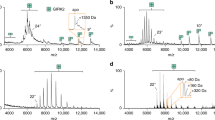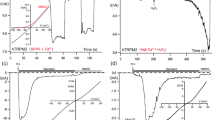Abstract
Receptors coupled to heterotrimeric guanine nucleotide-binding proteins (G proteins) activate phosphatidylinositol 4,5-bisphosphate (PtdIns(4,5)P2)-hydrolyzing phospholipase C (PLC) enzymes by activated α or free βγ subunits of the relevant G proteins. To study whether low molecular weight G proteins of the Rho family are involved in receptor signalling to PLC, we examined the effect of Clostridium difficile toxin B, which glucosylates and thereby inactivates Rho proteins, on the regulation of PLC activity in human embryonic kidney (HEK) cells stably expressing the m3 muscarinic acetylcholine receptor (mAChR) subtype. Toxin B treatment of HEK cells did not affect basal PLC activity, but potently and efficiently inhibited mAChR-stimulated inositol phosphate formation. PLC activation by the endogenously expressed thrombin receptor and by the direct G protein activators, AlF sup−inf4 and guanosine 5′-[γ-thio]triphosphate (GTPγS), studied in intact and permeabilized cells, respectively, were also inhibited by toxin B treatment. C3 exoenzyme, which ADP-ribosylates Rho proteins, mimicked the inhibitory effect of toxin B on GTPγS-stimulated PLC activity. Finally, both toxin B and C3 exoenzyme significantly reduced, by 40 to 50%, the total level of PtdIns(4,5)P2 in HEK cells, without affecting the levels of phosphatidylinositol and phosphatidylinositol 4-phosphate. Accordingly, when PLC activity was measured with exogenous PtdIns(4,5)P2 as enzyme substrate, Ca2+- as well as GTPγS- or A1F sup−inf4 -stimulated PLC activities were not altered by prior toxin B treatment. In conclusion, evidence is provided that toxin B and C3 exoenzyme, apparently by inactivating Rho proteins, inhibit G protein-coupled receptor signalling to PLC, most likely by reducing the cellular substrate supply.
Similar content being viewed by others
References
Aktories K, Just I (1993) GTPases and actin as targets for bacterial toxins. In: Dickey BF, Birnbaumer L (eds) GTPases in biology I. Springer, Berlin Heidelberg New York, pp 87–112
Berridge MJ (1993) Inositol trisphosphate and calcium signalling. Nature 361:315–325
Berstein G, Blank JL, Smrcka AV, Higashijima T, Sternweis PC, Exton JH, Ross EM (1992) Reconstitution of agonist-stimulated phosphatidylinositol 4,5-bisphosphate hydrolysis using purified ml muscarinic receptor, Gq/11, and phospholipase C-β1. J Biol Chem 267:8081–8088
Burgoyne RD (1994) Phosphoinositides in vesicular traffic. Trends Biochem Sci 19:55–57
Camps M, Hou C, Jakobs KH, Gierschik P (1990) Guanosine 5′-[γ-thio]triphosphate-stimulated hydrolysis of phosphatidylinositol 4,5-bisphosphate in HL-60 granulocytes. Evidence that the guanine nucleotide acts by relieving phospholipase C from an inhibitory constraint. Biochem J 271:743–748
Carpenter CL, Cantley LC (1996) Phosphoinositide kinases. Curr Opinion Cell Biol 8:153–158
Chong LD, Traynor-Kaplan A, Bokoch GM, Schwartz MA (1994) The small GTP-binding protein Rho regulates a phosphatidylinositol 4-phosphate 5-kinase in mammalian cells. Cell 79:507–513
Ciesielski-Treska J, Ulrich G, Rihn B, Aunis D (1989) Mechanism of action of Clostridium difficile toxin B: role of external medium and cytoskeletal organization in intoxicated cells. Eur J Cell Biol 48:191–202
Cunningham E, Thomas GMH, Ball A, Hiles I, Cockcroft S (1995) Phosphatidylinositol transfer protein dictates the rate of inositol triphosphate production by promoting the synthesis of PIP2. Curr Biol 5:775–783
Divecha N, Irvine RF (1995) Phospholipid signaling. Cell 80:269–278
Eichel-Streiber C von, Harperath U, Bosse U, Hadding U (1987) Purification of two high molecular weight toxins of Clostridium difficile which are antigenically related. Microb Pathogen 2:307–318
Eichel-Streiber C von, Laufenberg-Feldmann R, Sartingen S, Schulze J, Sauerborn M (1992) Comparative sequence analysis of the Clostridium difficile toxins A and B. Mol Gen Genet 233:260–268
Hartwig JH, Bokoch GM, Carpenter CL, Janmey PA, Taylor LA, Toker A, Stossel TP (1995) Thrombin receptor ligation and activated Rae uncap actin filament barbed ends through phosphoinositide synthesis in permeabilized human platelets. Cell 82:643–653
Janmey PA (1994) Phosphoinositides and calcium as regulators of cellular actin assembly and disassembly. Annu Rev Physiol 56:169–191
Just I, Fritz G, Aktories K, Giry M, Popoff MR, Boquet P, Hegenbarth S, von Eichel-Steiber C (1994) Clostridium difficile toxin B acts on the GTP-binding protein Rho. J Biol Chem 269:10706–10712
Just I, Selzer J, Wilm M, von Eichel-Streiber C, Mann M, Aktories K (1995a) Glucosylabon of Rho proteins by Clostridium difficile toxin B. Nature 375:500–503
Just I, Wilm M, Selzer J, Rex G, von Eichel-Streiber C, Mann M, Aktories K (1995b) The enterotoxin from Clostridium difficile (ToxA) monoglucosylates the Rho proteins. J Biol Chem 270:13932–13936
Lee SB, Rhee SG (1995) Significance of PIP2 hydrolysis and regulation of phospholipase isozymes. Curr Opinion Cell Biol 7:183–189
Lips DL, Majerus PW, Gorga FR, Young AT, Benjamin TL (1989) Phosphatidylinositol 3-phosphate is present in normal and transformed fibroblasts and is resistant to hydrolysis by bovine brain phospholipase C II. J Biol Chem 264:8759–8763
Liscovitch M, Chalifa V, Pertile P, Chen CS, Cantley LC (1994) Novel function of phosphatidylinositol 4,5-bisphosphate as a cofactor for brain membrane phospholipase D. J Biol Chem 269:21403–21406
Liscovitch M, Cantley LC (1995) Signal transduction and membrane traffic: the PITP/phosphoinositide connection. Cell 81:659–662
Offermanns S, Wieland T, Homann D, Sandmann J, Bombien E, Spicher K, Schultz G, Jakobs KH (1994) Transfected muscarinic acetylcholine receptors selectively couple to Gi-type G proteins and Gq/11. J. Mol Pharmacol 45:890–898
Paterson HF, Self AJ, Garrett MD, Just I, Aktories K, Hall A (1990) Microinjection of recombinant p21rho induces rapid changes in cell morphology. J Cell Biol 111:1001–1007
Peralta EG, Ashkenazi A, Winslow JW, Ramachandran J, Capon DJ (1988) Differential regulation of PI hydrolysis and adenylyl cyclase by muscarinic receptor subtypes. Nature 334:434–437
Pertile P, Liscovitch M, Chalifa V, Cantley LC (1995) Phosphatidylinositol 4,5-bisphosphate synthesis is required for activation of phospholipase D in U937 cells. J Biol Chem 270:5130–5135
Schmidt M, Hüwe SM, Fasselt B, Homann D, Rumenapp U, Sandmann J, Jakobs KH (1994) Mechanisms of phospholipase D stimulation by m3 muscarinic acetylcholine receptors. Evidence for involvement of tyrosine phosphorylation. Eur J Biochem 225:667–675
Schmidt M, Bienek C, van Koppen CJ, Michel MC, Jakobs KH (1995a) Differential calcium signalling by m2 and m3 muscarinic acetylcholine receptors in a single cell type. Naunyn-Schmiedeberg's Arch Pharmacol 352:469–476
Schmidt M, Fasselt B, Rumenapp U, Bienek C, Wieland T, van Koppen CJ, Jakobs KH (1995b) Rapid and persistent desensitization of m3 muscarinic acetylcholine receptor-stimulated phospholipase D. Concomitant sensitization of phospholipase C. J Biol Chem 270:19949–19956
Schmidt M, Rümenapp U, Bienek C, Keller J, von Eichel-Streiber C, Jakobs KH (1996) Inhibition of receptor signaling to phospholipase D by Clostridium difficile toxin B. Role of Rho proteins. J Biol Chem 271:2422–2426
Smrcka AV, Sternweis PC (1993) Regulation of purified subtypes of phosphatidylinositol-specific phospholipase Cβ by G protein α and βγ subunits. J Biol Chem 268:9667–9674
Wu L, Niemeyer B, Colley N, Socolich M, Zuker CS (1995) Regulation of PLC-mediated signalling in vivo by CDP-diacylglycerol synthase. Nature 373:216–222
Author information
Authors and Affiliations
Rights and permissions
About this article
Cite this article
Schmidt, M., Bienek, C., Rümenapp, U. et al. A role for Rho in receptor- and G protein-stimulated phospholipase C Reduction in phosphatidylinositol 4,5-bisphosphate by Clostridium difficile toxin B. Naunyn-Schmiedeberg's Arch Pharmacol 354, 87–94 (1996). https://doi.org/10.1007/BF00178707
Received:
Accepted:
Issue Date:
DOI: https://doi.org/10.1007/BF00178707




